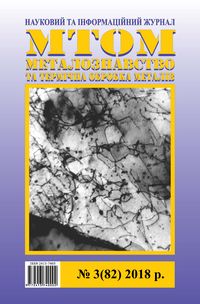To the problem of estimation of the influence of icing on the aircraft
DOI:
https://doi.org/10.30838/J.PMHTM.2413.250918.10.393Keywords:
flight safety, icing intensity aircrafts icing, numerical simulation, Reynolds-averaged Navier-Stokes equationsAbstract
Adstract. Statement of the problem. The question of the qualitative and quantitative determination of the degree of negative influence of icing on the aircraft during the flight in adverse meteorological conditions, which has a specific layout, configuration and size, is quite complex and still remains far from completion. To solve this problem, an integrated approach based on the developed methodology and software support, which allows numerical simulation of the icing processes of the aerodynamic surfaces of aircraft has been proposed. When describing the airborne flow, an approach based on solving Reynolds-averaged Navier−Stokes equations using the Spalart−Allmaras turbulence model, in which the motion of supercooled water droplets is described using an interpenetrating media model, was proposed. Numerical simulation of the icing process on a streamlined surface was performed using the method of surface control volumes, based on the equations of continuity, conservation of momentum and energy. Calculation results. Systematic multiparameter studies of icing processes in a wide range of parameters using asan example of the NACA 0012 profile were carried out. Conclusions. The possibility of applying the obtained results in ensuring flight safety, designing deicing/antiicing protection systems, according to the regulatory documentation rules, was illustrated. Systematization of the results that can be obtained for a given aircraft, including one equipped with an ice protection system, will allow objectively, quickly and accurately analyze the danger of icing along the planned route during all phases of flight in known meteorological conditions, as well as during flight, using current data on the state of the atmosphere, to develop recommendations for changing the flight plan.
References
Jeck R.K. A History and Interpretation of Aircraft Icing Intensity Definitions and FAA Rules for Operating in Icing Conditions.Technical report, DOT/FAA/AR-01/91,November,2001,43 p.
Aeronautical Information Manual (AIM), updated annually; Federal Aviation Administration, Washington, DC 20590.
Federal Aviation Regulations, in “Code of Federal Regulations, Title 14, Aeronautics and Space” updated periodically; Federal Aviation Administration, Washington, DC 20590.
Alekseyenko S.V. and Prikhod’ko A.A. Mathematical Modeling of Ice Body Formation on the Wing Airfoil Surface :monograph.Fluid Dynamics,2014, vol. 49, no.6, pp. 715–732.
Prikhod’ko A.A. and Alekseyenko S.V. Numerical Simulation of the Processes of Icing on Airfoils with Formation of a “Barrier” Ice. Journal of Engineering Physics and Thermophysics, vol. 87, iss. 3, 2014, pp. 598–607. DOI:10.1007/s10891-014-1050-0.
Alekseyenko S.V. and Prykhod’ko O.A. Numerical simulation of icing of a cylinder and an airfoil: model review and computational results.TsAGI Science Journal, vol. 44, iss. 6,2013, pp. 761–805.
Lewis W. Meteorological Aspects of Aircraft Icing.Compendium of Meteorology. American Meteorological Society, Boston, Massachusetts,1951, pp. 1197–1203.
Thompson J.K. All-Weather Flight Concern of the Pilot and Weather Forecaster : monograph. Aeronautical Engineering Review,July,1956,66 p.
Mitchell L.V. Aircraft Icing-A New Look.Aerospace Safety. Published by the U. S. Air Force,Dec.,1964, pp. 9–11.
Werner J.B. Ice Protection Investigation for Advanced Rotary-Wing Aircraft. USAAMRDL Technical Report 73–38, published by U.S. Army Air Mobility Research and Development Laboratory, Fort Eustis, Virginia, August,1973, pp. 113–124.
Rosemount Model 871FN/512AG Icing Rate System, Product Data Sheet 2517 (Rev. June 1998), B.F. Goodrich Aircraft Sensors Division, 14300 Judicial Road, Burnsville, MN 55306.
FAA Inflight Aircraft Icing Plan,April,1997,Federal Aviation Administration, 800 Independence Ave., S.W., Washington, DC 20590.
SpalartP.R. andAllmarasS.R. A one-equation turbulence model for aerodynamic flow: monograph.AIAA Paper, no.92,0439,1992,22 p.
Aupoix B. and Spalart P.R. Extensions of the Spalart-Allmaras Turbulence Model to Account for Wall Roughness.International Journal of Heat and Fluid Flow, vol. 24,2003, pp. 454–462.
Alekseyenko S., SinapiusM., SchulzM. and PrykhodkoO.Interaction of Supercooled Large Droplets with Aerodynamic Profile.SAE Technical Paper,2015–01–2118, 2015,12 р.
Alekseyenko S.V., Mendig C., Schulz M., Sinapius M. and Prikhod’ko A.A. An Experimental Study of Freezing of a Supercooled Water Droplet on a Solid Surface. Technical Physics Letters, 2016, vol. 42, no. 5, pp. 524–527. DOI:10.1134/S1063785016050187.
Roe P.L. Annual review of fluid mechanics,1986, vol. 18, pp. 337–365.
Advisory Circular of Federal Aviation Administration 20-73А. Aircraft ice protection, August16, 2006,233 р.
Downloads
Published
Issue
Section
License
Authors that are published in this journal agree to follow the conditions:
Authors reserve the right to the authorship of his work and cede the right to the journal of first publication of this work on conditions of the license under the Creative Commons Attribution License, which allows others to distribute it freely with the obligatory reference to the author of the original work and the first publication of the work in this journal.

